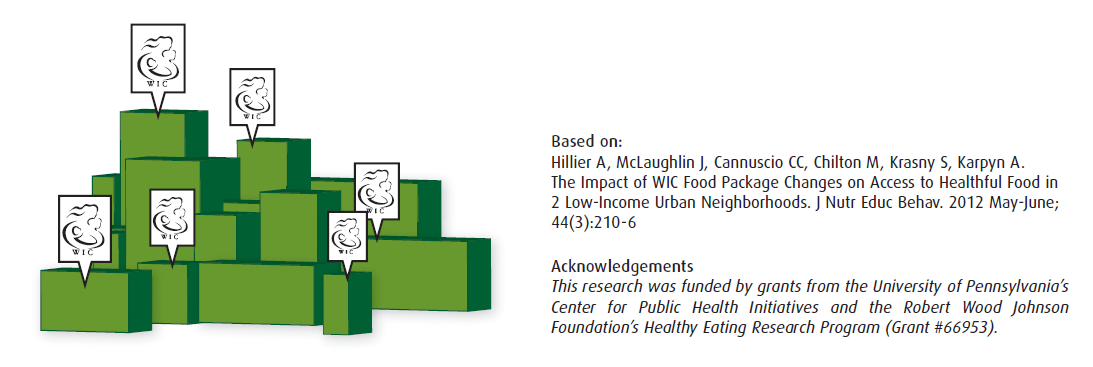The Impact of WIC Food Package Changes on Access to Healthful Food in 2 Low-Income Urban Neighborhoods
This study tested the hypothesis that the changes to the WIC food package would increase the availability of healthful food at WICparticipating retailers—a major urban food source for both WIC participants and nonparticipants. It used a pre- and postintervention design to assess the impact of the changes on stores in two adjacent low-income neighborhoods in Philadelphia.
Food Store Surveys
Trained research assistants surveyed every store located within the 3.6-square mile study area twice using a modified version of the Nutrition Environment Measure Survey for Stores (NEMS-S)*, once in the spring of 2009 (baseline), and once in spring 2010 after the changes were implemented. The NEMS-S instrument was modified for this study by adding frozen and canned vegetables, canned and dried beans, tofu, canned fish, whole-grain tortillas, and brown rice. Fresh fruits and vegetables, whole grain bread, reduced fat milk, 100% juice, and low-sugar whole-grain cereal are included in the standard NEMS-S instrument.
Higher NEMS-S score indicate more diverse : inventory of healthful food items
The primary outcome measure was the NEMS-S scores at baseline and in 2010. Higher scores indicate more diverse inventory of healthful food items of acceptable quality and equivalent prices for healthful and less healthful items. Paired t tests were used to determine whether the changes in NEMS-S score were statistically significant. Ordinary least squares (OLS) regression models were calculated to determine whether the baseline NEMS-S score, WIC store participation status, type of food store, percentage Hispanic residents (block group), and median household income (block group) were significant predictors of 2010 NEMS-S scores.
Scores have significantly increased since baseline
At total of 115 stores were surveyed at both time periods. Corner stores consistently scored the lowest (mean = 14.1 at baseline, 20.7 in 2010) and the four chain supermarkets scored the highest (mean = 38.0 at baseline, 44.0 in 2010). NEMS-S scores increased significantly between baseline and 2010, indicating that all stores were stocking more healthful food by the second year (change in NEMS-S score from 11.9 to 16.0, P < .01), but WIC-approved stores had more healthful foods at baseline and saw a greater increase in the availability.
Across both WIC and non-WIC stores, the most considerable improvements were in the milk, juice, and whole-grain categories. Only 50.0% of stores carried reduced-fat milk at baseline; 77.0% of those same stores carried reduced-fat milk in 2010. Only 33.0% of stores carried whole-grain bread at baseline; 52.0% of them carried whole-grain bread in 2010. Only 25.0% of stores carried brown rice at baseline; 55.0% of them carried brown rice in 2010. Improvements in fruits and vegetables were more modest. The OLS regression model showed that baseline NEMS-S score, WIC status, and type of store were all significant positive predictors (P< .01) of 2010 scores.
Federal subsidy of specific healthful food items had positive results
This study demonstrated that a federal subsidy of specific healthful food items was associated with statistically significant and meaningful changes in the food environment in two lowincome neighborhoods. The results suggest that by subsidizing specific healthful food items and requiring that participating vendors stock them, the 2009 WIC food package changes may increase the access all residents have to healthful food. Results also indicate substantial variation in the availability of healthful food across food stores even after the food package changes, particularly within small corner stores. State WIC agencies might consider changing procedures for authorizing and inspecting food stores that participate in the WIC program and changing minimum food inventory guidelines to reduce this variability. Further research on the implications of food store choice on the types of food that WIC participants choose is needed, but it may be advisable for WIC agencies to discuss the type of food stores where participants shop as part of their nutrition education.

References
Glanz K, Sallis JF, Saelens BE, Frank LD. Nutrition Environment Measures Survey in Stores (NEMS-S): development and evaluation. Am J Prev Med. 2007; 32:282-289.
